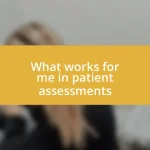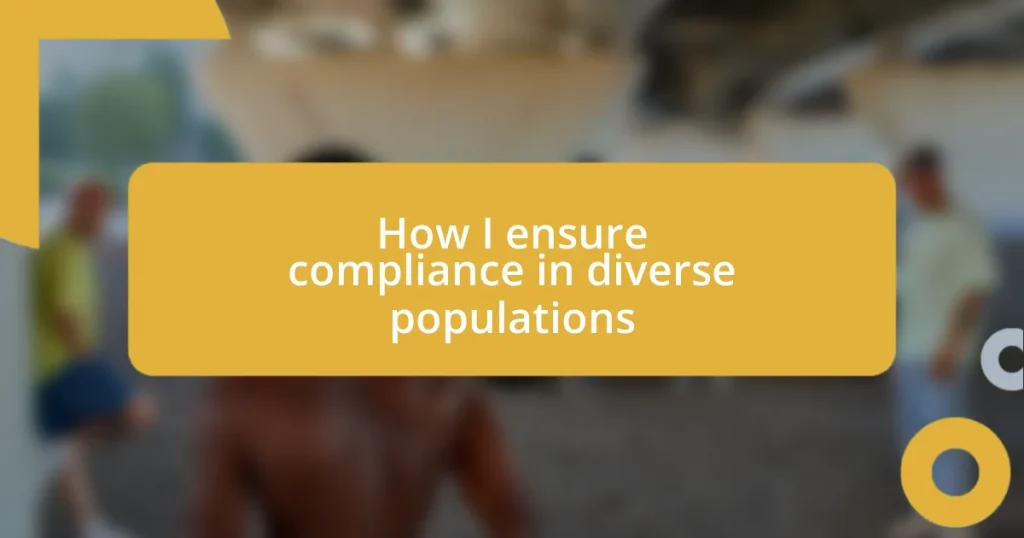Key takeaways:
- Empathy and community involvement are essential for effectively understanding and meeting the diverse needs of populations.
- Implementing feedback mechanisms and adjusting strategies based on community input enhances compliance and fosters trust.
- Cultural competence training for staff improves communication and better outcomes when engaging with diverse groups.
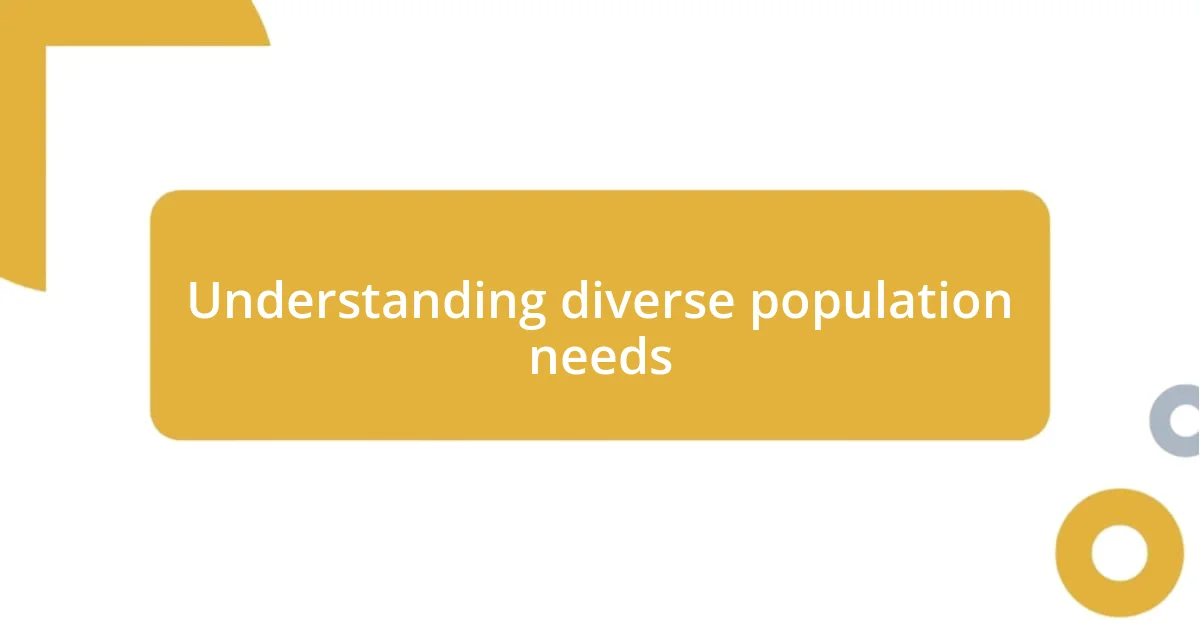
Understanding diverse population needs
Understanding the needs of diverse populations requires not just knowledge, but empathy. I remember a time when I led a workshop for a group of individuals from various cultural backgrounds. The conversations opened my eyes to how differences in communication styles and values significantly impact engagement. Isn’t it fascinating how our upbringing shapes our perspectives on health, education, and community support?
In my experience, adapting to the unique characteristics of each group is crucial. For example, while working with a community of refugees, I learned the importance of language services and cultural liaisons. These resources foster trust and make individuals feel seen. That experience taught me that ensuring compliance isn’t about enforcing rules but about meeting people where they are.
Reflecting on these interactions makes me realize how vital it is to involve community members in the decision-making process. When I engaged local leaders in a health initiative, it didn’t just enhance participation; it enriched the program’s relevance. How often do we overlook those who can provide valuable insights simply because we think we know what’s best?
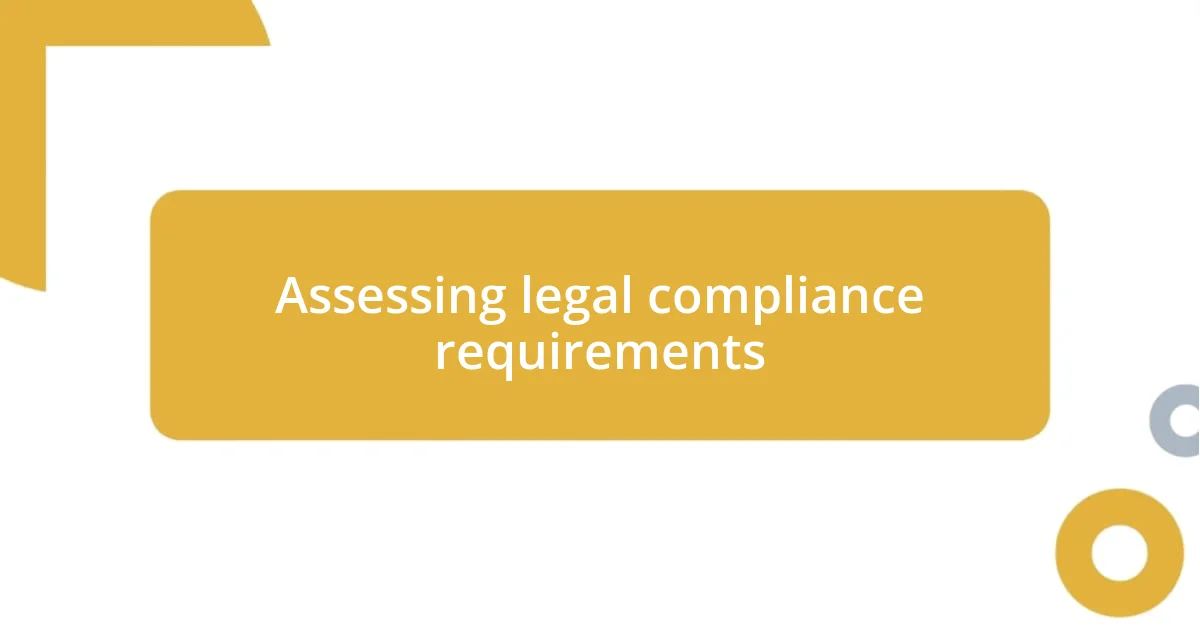
Assessing legal compliance requirements
When assessing legal compliance requirements, it’s essential to understand the specific regulations that apply to various demographics. I recall a scenario when I evaluated compliance requirements for a health program tailored for immigrant populations. It struck me how different countries have unique health regulations that must be honored. To me, it’s a balancing act of ensuring that we adhere to the law while also meeting the community’s unique needs.
It’s not just about interpreting the law; it’s also about being aware of the existing barriers diverse populations face. For instance, while working on a project with a Native American tribe, I realized that historical contexts influence their interaction with legal systems. This taught me that understanding compliance isn’t merely a compliance checklist; it’s about creating an environment where marginalized voices feel valued and heard.
Moreover, I find it beneficial to utilize a variety of evaluation methods when assessing compliance. Surveys, focus groups, and community meetings provide insights that are often overlooked in traditional assessments. In my experience, these methods can unveil crucial aspects of legal compliance, fostering a collaborative atmosphere. How often do we truly engage with the communities we serve to ensure that the regulations in place are not only enforced but understood and respected?
| Method | Purpose |
|---|---|
| Surveys | Gather quantitative data to identify issues |
| Focus Groups | Facilitate in-depth discussions on community needs |
| Community Meetings | Promote transparency and collective input |
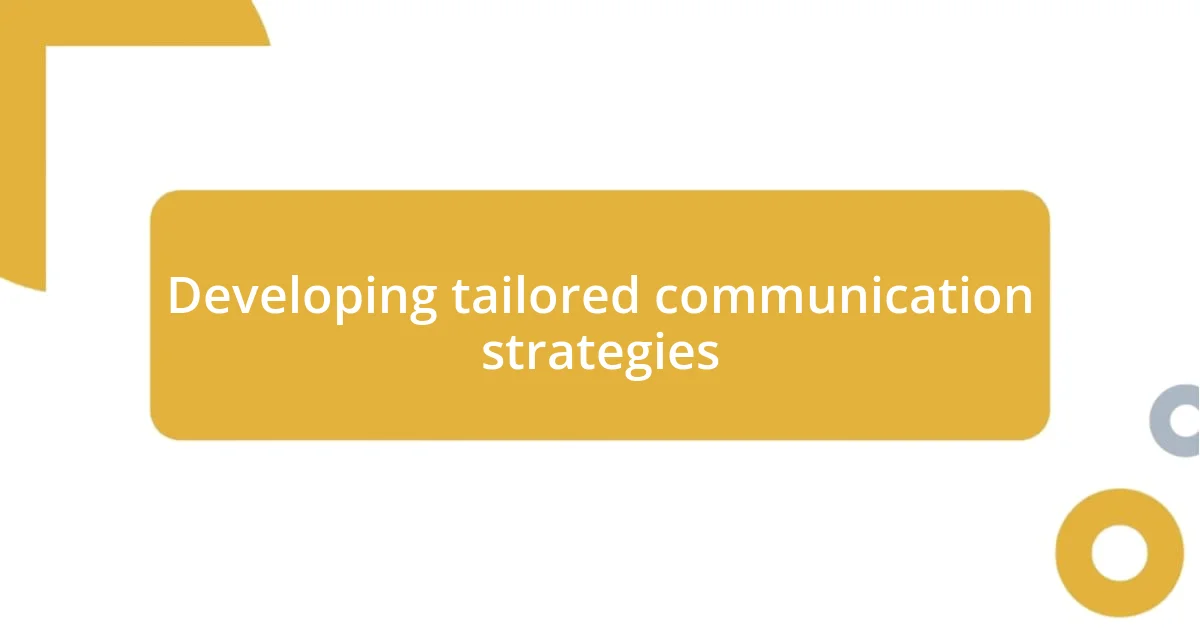
Developing tailored communication strategies
When developing tailored communication strategies, I’ve found it’s essential to embrace a variety of approaches that resonate with the specific community I’m engaging with. One memorable experience I had was while collaborating with a group of seniors from diverse backgrounds. I decided to create visual aids and translated materials, which not only simplified complex information but also sparked vibrant discussions. I watched them light up when they could see their culture reflected in the communication; it reminded me how powerful inclusivity can be in fostering understanding.
To ensure effective communication, consider these strategies:
- Leverage technology: Use apps and platforms that allow for real-time translation and accessibility features.
- Culturally relevant materials: Create flyers and brochures that resonate with cultural values and practices.
- Engage local ambassadors: Collaborate with community leaders who understand the nuances of their groups to help bridge communication gaps.
I often marvel at how these adjustments not only enhance understanding but also build lasting relationships. It’s genuinely rewarding to know that by listening and adapting, I can make a meaningful difference in someone’s willingness to engage and comply.
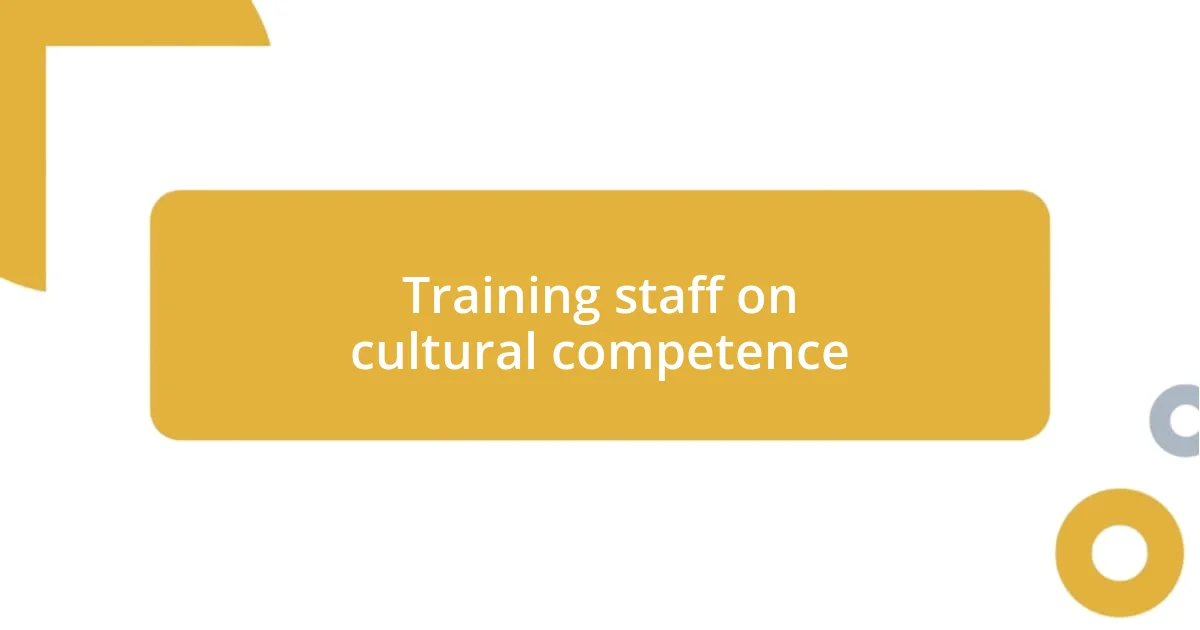
Training staff on cultural competence
Training staff on cultural competence is not just a box to check; it’s an ongoing journey that shapes how we interact with diverse populations. I remember participating in a training session where staff were encouraged to share personal experiences related to their own cultural backgrounds. This exercise opened my eyes to the rich tapestry of perspectives within our team and highlighted how vital it is to acknowledge and respect these differences in our work with clients.
Through practical workshops focused on role-playing and real-life scenarios, I’ve seen how staff become more empathetic and effective communicators. In one instance, a colleague described a situation where they had to navigate a conversation with a client from a different culture, and the training helped them pull from their newfound understanding rather than rely on assumptions. It was a transformative moment that truly reinforced how cultural competence can lead to better outcomes for everyone involved.
To foster ongoing growth in cultural competence, I advocate for regular discussions and reflections among staff. How often do we pause to reflect on our interactions with diverse populations? By integrating this practice into our routines, we can ensure that our understanding evolves alongside the communities we serve, ultimately creating a more inclusive, respectful environment that benefits everyone.
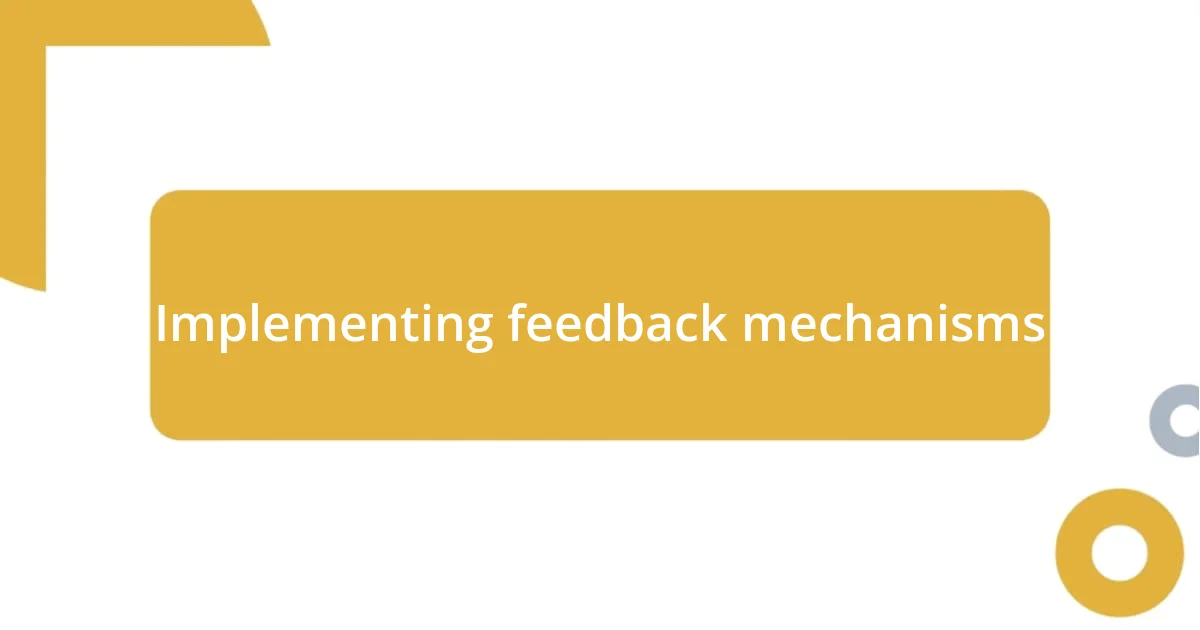
Implementing feedback mechanisms
Feedback mechanisms are a critical component in enhancing compliance among diverse populations. I vividly recall a time when I implemented a simple digital survey after a community event. The responses were eye-opening! One participant highlighted that our schedule didn’t accommodate their family commitments, and that prompted me to rethink future planning. It’s amazing how just asking the right questions can unveil insights that otherwise go unnoticed.
Moreover, I’ve found that creating focus groups can foster deeper conversations and trust. In one of these sessions, I encouraged participants to share not just their experiences but also suggestions for improvement. The atmosphere was enlightening—people felt heard and valued, and the recommendations we gathered led to immediate changes in our outreach strategies. Isn’t it fascinating how the power of listening can lead to practical solutions?
I believe consistent feedback is vital for continuous improvement, yet it can feel daunting to implement. I often wonder, how can we ensure that individuals from diverse backgrounds feel comfortable giving feedback? My experience has shown that establishing anonymous feedback channels can encourage honesty, allowing those who might be hesitant to speak up in public forums to share their thoughts freely. It’s all about building a safe space for open dialogue, which ultimately drives better compliance and community engagement.
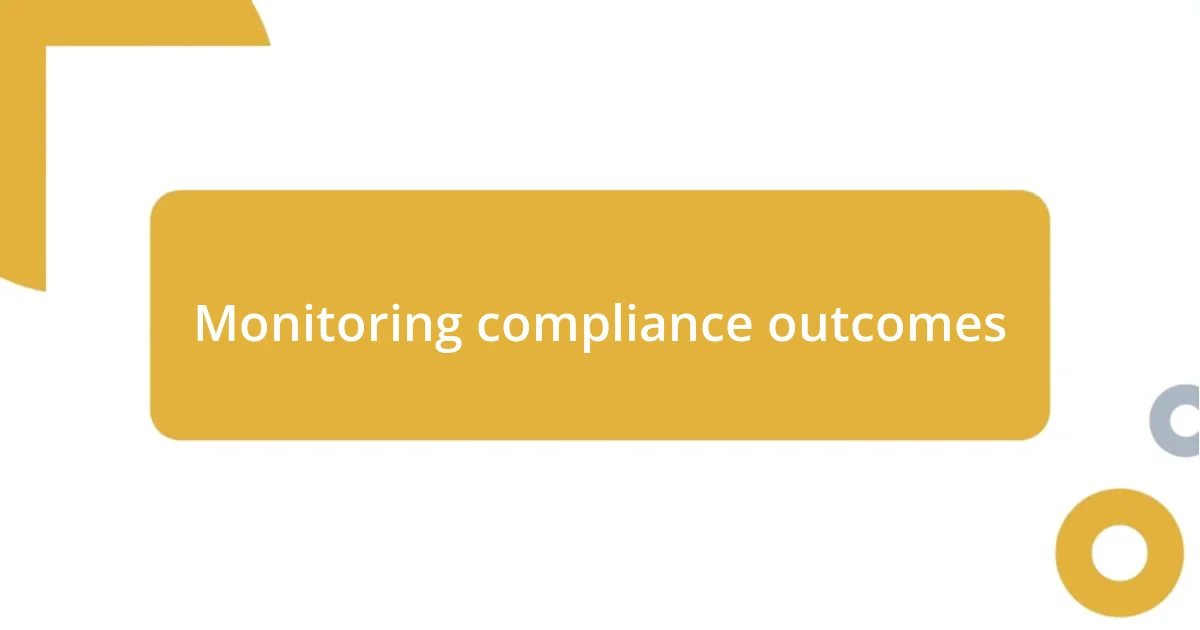
Monitoring compliance outcomes
Monitoring compliance outcomes is where we really see the impact of our efforts. I remember analyzing compliance data after we introduced new training for our staff. The numbers were encouraging, but what struck me more was hearing directly from clients about their experiences. One client shared a story of feeling truly understood for the first time, which is an outcome that data alone can’t capture. It reminded me that numbers are just one piece of the puzzle; the emotional resonance of our work speaks volumes.
In another instance, I decided to conduct follow-up interviews with clients after they participated in our programs. It was enlightening to hear their perspectives on how our services had evolved. One participant expressed frustration over previous misunderstandings, but they also conveyed a sense of hope and engagement with our changes. It made me realize how vital it is to not only monitor compliance through metrics but to genuinely connect with the individuals we serve. This two-way communication deepens our understanding and fosters a culture of accountability.
Tracking compliance isn’t just about checking off boxes; it’s an ongoing dialogue that shapes future strategies. When I think about the role feedback plays, I ask myself: Are we truly listening? I believe that regular reviews of compliance outcomes should include diverse voices. By sharing insights and making adjustments based on real experiences, we can create an environment where everyone feels valued. After all, it’s not just about meeting requirements; it’s about making meaningful connections that enhance our collective efforts.
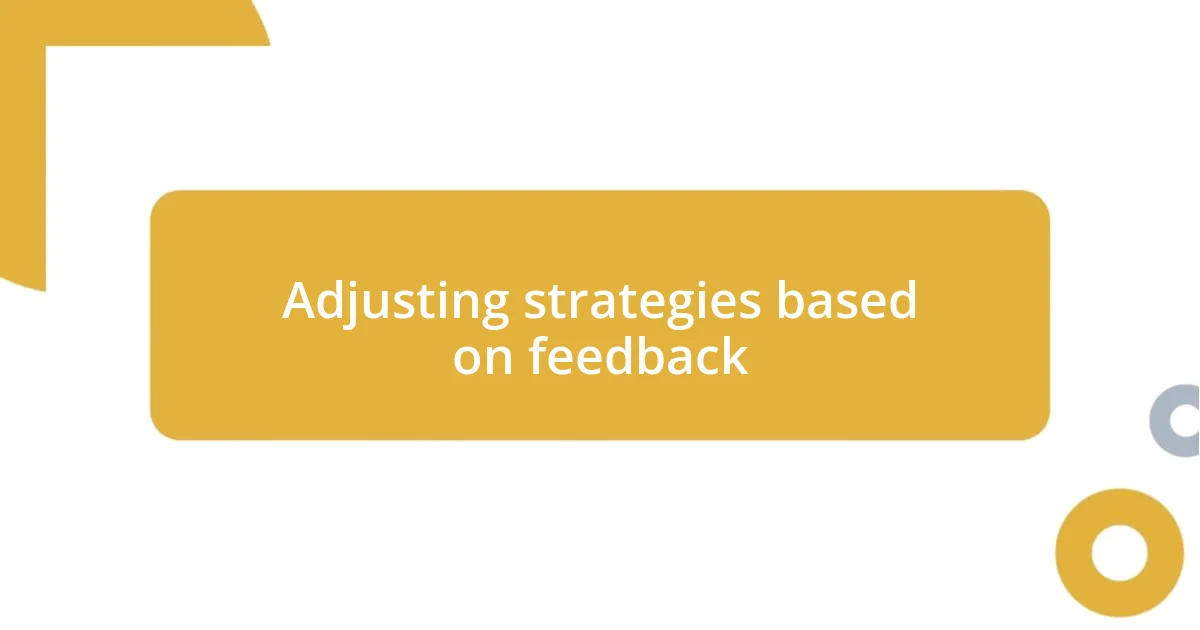
Adjusting strategies based on feedback
Receiving feedback is only the beginning; adjusting strategies based on that feedback is where the real magic happens. I once organized a workshop that aimed to educate participants on compliance practices, yet feedback revealed that many attendees felt overwhelmed by the jargon we used. That was a wake-up call for me! Instead of sticking with my usual buzzwords, I started to simplify the language and incorporate relatable examples. The next workshop saw an increase in participant engagement—proof that adapting based on feedback can lead to more effective outreach.
During another initiative, we implemented a mentorship program intended to support underrepresented individuals. Initial feedback expressed confusion about the pairing process, which wasn’t as clear as I had anticipated. After recalibrating how we matched mentors with mentees, I noticed a tangible shift; participants reported not just feeling more connected, but also more empowered in navigating compliance issues together. Isn’t it enlightening how minor tweaks can significantly enhance a program’s impact?
I’ve also learned that flexibility is crucial. In a community meeting aimed at discussing compliance strategies, I noticed a slight disengagement when I pitched my ideas too rigidly. Recognizing the need for a more dynamic approach, I opened the floor for suggestions midway through the session. The responses were invigorating! People began to share innovative ideas I had never considered. It emphasized for me how our strategies must evolve through collaboration—leaving room for diverse opinions can create a more inclusive, effective outcome. What have you experienced when you’ve embraced feedback openly?

